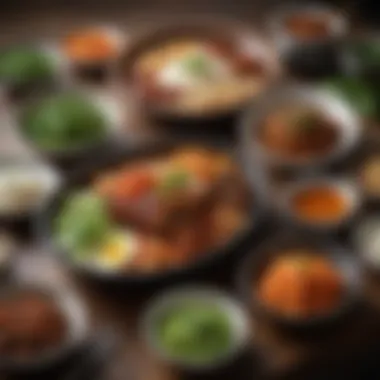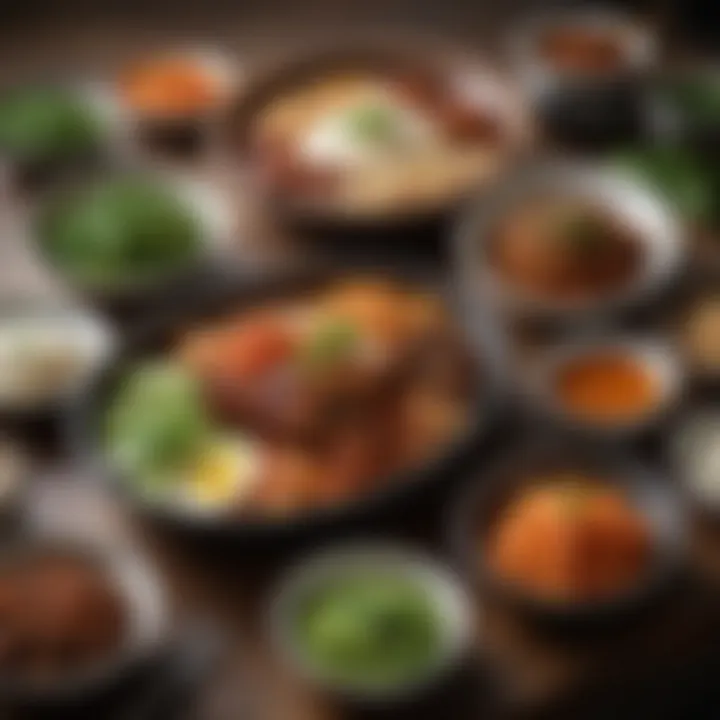Exploring Popular Korean Food: A Culinary Journey


Intro
Korean cuisine is distinctive and captivating, greatly influenced by centuries of history, culture, and agricultural practices. Its richly layered flavors and colorful presentations make it stand out. The various dishes serve not just as meals but symbolize communal connection and shared experience.
Senors not attached to labels might find familiar and new tastes blended together. Young and old enjoy the range of dishes available. Whether you have a busy lifestyle or seek a culinary adventure, this guide will help you delve into Korean food's significance and mixing elements in daily cooking. Ready to explore?
Recipe Highlight
Let's dive into a popular and approachable dish, Kimchi Fried Rice. This beloved dish combines hearty and fermented flavors while being simple to prepare. Kimchi is a crucial element in Korean cuisine, representing fermentation cooking process simplicity.
Essential ingredients:
- Cooked rice (preferably a day old)
- Kimchi (about 1 cup)
- Egg (1 per serving)
- Green onions (2, chopped)
- A splash of soy sauce or gochujang (Korean chili paste)
- Vegetable oil or sesame oil (for frying)
Preparation Time:
15 minutes
Servings:
2-3 servings
Step-by-Step Instructions
- Preheat your oil: In a non-stick pan or wok, heat a tablespoon of vegetable oil over medium heat.
- Add kimchi: Throw in your chopped kimchi and sauté for 2-3 minutes, allowing it to cook and bring out more flavors.
- Stir in the rice: Add cold, cooked rice to the pan. Integrate it with the kimchi, breaking up clumps.
- Season: Pour a splash of soy sauce or gochujang on the rice and mix well. Adjust seasoning according to your preference.
- Cook the egg: Move the rice mix to one side of the pan. Crack an egg into the clear space and scramble it until thickened, then combine with the rice.
- Garnish: Stir in chopped green onions for freshness.
- Serve: Drizzle sesame oil for extra flavor before you serve.
One common mistake is sticking to warm rice if not cooked properly. Fine white rice creates the best texture for fried rice.
Variations and Substitutions
To modify the dish for dietary needs, you may want alternatives:
- Use quinoa in place of rice for added fiber.
- Tofu or chicken can replace the egg for added protein.
- Switch standard vegetables like peas or carrots to add color.
To infuse more taste, try adding garlic or various vegetables. Consider pairing it with side dishes like pickled radish.
Time-Saving Cooking Tips
Efficiency can make cooking pleasurable. Here are tips:
- Prep ahead by chopping ingredients at the beginning of the week.
- Using a rice cooker saves time and effort.
- Batch-cooking multiple servings helps in preparing meals easily during the busy week.
Using tools like food processors can also make vegetable preparation much quicker.
Nutritional Information
Kimchi Fried Rice:
- Calories per serving: About 350-400 calories
- Key nutrients: Rich in proteins, fibers, and beneficial probiotics from kimchi.
This dish fits multiple diet plans since it's easily adjustable to gluten-free using tamari or modifying for the vegan versions. It supports healthy gut flora, making this dish favored by nutritious food enthusiasts.
Korean cuisine is recovered easier if knowledge about involved key ingredients is understood.
Cultivating an understanding and appreciation of Korean cooking will enrich both personal routines and shared meal experiences.
Preface to Korean Cuisine
Korean cuisine presents a fascinating blend of flavors, textures, and colors. Understanding this culinary landscape is crucial for anyone seeking to appreciate the depth of Korean food culture. Notably, it is not merely about sustenance; Korean cuisine reflects the historical journey and cultural evolution of the nation. Through its diverse offerings, one can gain insights into social practices, regional ingredients, and agricultural heritages.
Cultural Significance


Korean food is deeply intertwined with traditions and social ethos. Meals are often considered communal experiences, emphasizing connection and shared values. For instance, most dishes are meant to be savored with others, thereby fostering relationships. This way, food becomes a medium for expressing care and hospitality. Certain foods, like rice and kimchi, hold profound cultural symbolism.
“Food often acts as a bridge connecting people across generations and cultures.”
Additionally, each Korean festival has specific foods associated with it, such as tteok for celebrations or japchae during birthdays. This shows how cooking and eating habits evolve in respect to traditions and customs, making meals a ritualistic event rather than mere consumption.
Historical Background
The roots of Korean cuisine can be traced back centuries. Historical influences have shaped each era’s dining practices. Korea's geography plays a critical role, as its mountains and rivers foster a variety of local ingredients. Over the years, invasions and trade has introduced foreign spices and cooking styles, enriching the palate.
The earliest Koreans relied on hunting, fishing, and agriculture. Therefore, grains like rice, barley, and millet became staples. Later, the establishment of the Goryeo dynasty introduced more diversity in culinary techniques, including fermentation methods that led to the popularity of doenjang and gochujang. Fast forward to the modern era; Korean food has continued to thrive and adapt, gaining recognition worldwide, reflecting its vibrant cultural treasure.[^1]
The evolution and preservation of these culinary traditions are noteworthy not only from a nutritional standpoint but also in terms of cultural identity as an integral part of daily Korean life.
Key Ingredients in Korean Cooking
Korean cooking thrives on a rich palette of ingredients that each contribute to its unique and vibrant flavors. Understanding these key components is essential for anyone wishing to appreciate or replicate Korean dishes. Key ingredients serve not only as the foundation for many recipes but also enhance the overall experience associated with the cuisine.
Staple Ingredients
Korean cuisine is characterized by a limited yet powerful selection of staple ingredients that differentiate it from other culinary traditions. Rice is at the core; nearly every meal features it either as a base or a side. Wheat noodles, also famous in dishes like Japchae, provide a delightful texture and chewiness. Other staples include soybeans, which contribute to protein-rich products like tofu and soy sauce. Additionally, seafood is prevalent, serving both as a main dish or a key component in broths—dishes such as jjigae showcase this element.
In the preparation of kimchi, fermented cabbage becomes a staple item that draws upon the complex fermentation process, ensuring a deep umami flavor. Ultimately, these ingredients create a broader understanding of Korean dining, framing an essential narrative for those uninitiated.
Common Seasonings and Sauces
The flavor profiles of Korean food largely rely on a specific array of seasonings and sauces that accentuate their dishes. Gochujang, a fermented red chili paste, adds both heat and depth, rendering it indispensable in marinades and stews. Doenjang, a type of soybean paste, also stands out by imparting a unique earthy flavor in many dishes.
Moreover, the use of sesame oil and garlic brings a fragrant dimension that elevates dishes and balances flavors beautifully. For traditional dipping sauces, soy sauce, sometimes combined with rice vinegar, serves to enhance steamed or pan-fried dishes, exemplifying simplicity yet sophistication. Understanding these seasonings will empower cooks and food enthusiasts to craft authentic Korean meals.
Importance of Fresh Produce
In Korean cooking, fresh produce is not merely a recommendation but a cultural necessity. From seasons of nontoxic leafy greens utilized in salads or as side dishes to root vegetables that undergo fermentation, freshness defines quality and flavor in Korean cuisine. Key institution of contrasts involves the mixing of textures: crunchy radishes with soft, flaky fish or chewy noodles paired with fresh veggies.
Vegetables maintain not only visual appeal but also nutritional integrity. They contribute essential vitamins and minerals while forming a vibrant framework for any dish. Spring onion and perilla leaves offer layered flavors while being commonly recognized in various recipes, attesting to the vitality of using seasonal, fresh produce.
A focus on quality ingredients signifies an understanding of cultural identity rooted in sustainability and attention to health in the realm of food.
Popular Korean Dishes
Korean cuisine presents a rich tapestry of flavors, textures, and traditions. The section on popular Korean dishes invites readers to engage with a variety of meals that reflect cultural values and communal experiences. Not only do these dishes showcase unique cooking methods, but they also highlight local ingredients and introduce enticing flavors that are both pleasing and nutritious in everyday cooking.
Kimchi
Types of Kimchi
Understanding the types of kimchi offers insight into Korean gastronomic diversity. Kimchi serves as both a side dish and an essential element in other recipes. The varieties are numerous, from spicy napa cabbage kimchi to milder versions made from radish or cucumber. This diversity encourages experimentation with flavors, allowing cooks to match the dish with personal preferences or dietary restrictions. Each type brings a specific flavor and fermentation level, vital in pursuing a balanced palate in meals that may help enhance overall well-being.
Preparation Techniques
The preparations varied in kimchi preparation reflect traditional Korean techniques. Mastering these methods contributes significantly to authentic culinary execution. Fermentation, a cornerstone of kimchi-making, yields unique tastes through natural preservation methods. Traditionally, kimchi is prepared in advance to enhance its flavor. The timeframe can be adjusted based on personal taste as well as the dish's purpose. The effective integration of fresh ingredients during this process is crucial in creating not only delicious but also health-conscious dishes.
Bibimbap
Ingredients and Variations
Bibimbap is a harmonious mix of flavors and colors significant in Korean cuisine. Each ingredient plays a role, from the seasoned vegetables to the flavorful meat, all served over rice. The unique characteristic is that variations exist both regionally and personally. Changing the ingredients based on availability makes it adaptable, benefiting many households with diverse preferences. For instance, substituting different vegetables or proteins caters to seasonal variations or personal dietary choices.
Serving Suggestions
Bibimbap is not just visually appealing, but how it is served also adds charm. Typically, it is served in a hot stone bowl. This enhances meal experience, allowing mixed ingredients to meld beautifully while providing textural contrast with crispiness at the bottom of the bowl. Serving it with a side of spicy gochujang sauce introduces an extra layer of flavor, making the dining occasion enjoyable and memorable.


Bulgogi
Marinades
Marinades in bulgogi formation carry significant importance in defining its flavor. Traditionally, marinated beef is prepared with a mixture of soy sauce, sugar, sesame oil, and garlic. This distinctive combination elevates the dish, creating a balance of sweetness and umami flavors that can engage even novice cooks. Enhanced marination not only sâu flavors but also tenderizes meet crucially benefitting any homemade meal.
Cooking Methods
Cooking methods for bulgogi are versatile. Common techniques, such as grilling or pan-frying, provide unique results while maintaining moisture. The choice directly affects flavor, retaining juices and aroma. It allows cooks to experience different aspects of this traditional dish, making bulgogi a foundational staple in everyday cooking.
Japchae
Ingredient List
Understanding the ingredient list for japchae is critical to capturing its essence. The unique texture comes from sweet potato noodles, first boiled and then stir-fried. The addition of vegetables like carrot and spinach adds a refreshing touch making it a healthier option. Each addition brings out a fresh flavor profile enriched through natural elements, aiming for balance in both nutrition and enjoyment. Readers should appreciate that personal preferences can significantly alter the final product, offering endless possibilities tailored to culinary desires.
Preparation Steps
Preparation steps in crafting japchae reveal the straightforward nature of this beloved dish. Cooking the ingredients individually before combining them helps in preserving the distinct flavors found in each item. Carefully stir-frying enables flavor fusion to flourish, engaging the cook in an interactive journey towards a satisfying meal. Emphasis on the preparation can develop skills in timing and technique, serving as an introductory avenue for Korean inspiration on kitchen creativity.
Tteokbokki
Street Food Version
The street food version of tteokbokki has established itself as emblematic of Korean casual dining culture. The spiciness and chewiness awaken senses, displaying authenticity through the use of gochujang sauce. This fun, comforting dish offers a glimpse into culinary trends through its popularity among local vendors and continues to appeal to consumers of various ages and backgrounds. The component of enjoying food with communal feeling holds back the virtue of sharing experiences tied to Korean history while resonating with new food cultures worldwide.
Home Cooking Tips
Home cooking tips for recreating tteokbokki's iconic street-version are beneficial for anyone looking to cultivate this fiery dish in their own kitchen. Key techniques include determining optimal sauce consistency between sweetness and spiciness. Further considerations of using fine rice cake textures allow exploration of variety through cooking styles. -Engaging households under its unique accessibility provides an immediate connect with the culture while mastering important guidelines for Korean cuisine makes the cooking experience rewarding.
The Art of Korean Cooking
Korean cooking, and entire discipline in itself, holds both tradition and innovation in its essence. This section explores the critical facets of Korean cooking that enable its distinctive flavor profiles and culinary artistry. Understanding this art is essential not just for enhanced meal preparation but for appreciating the cultural narratives encoded within every dish and ingredient. This exploration reveals techniques and philosophies that guide Korean cooks, allowing readers to elevate their culinary skills and indulge in a richer experience of Korean cuisine.
Essential Cooking Techniques
Korean cooking employs several foundational techniques that are essential for any aspiring cook. These methods have been passed down for generations, attaching importance to both the cooking process and presentation. Some of the core techniques include:
- Pan-frying: Commonly used for dishes like bulgogi, this technique retains moisture and flavor.
- Steaming: Capture the essence of vegetables and proteins, offering a light texture while minimizing caloric intake.
- Grilling: Especially favored in Korean barbecues for its smoky char and heightened flavor complexity.
- Stir-frying: Allows quick cooking, perfect for maintaining crispness in vegetables.
Each technique brings out unique flavors and textures, forging an indispensable link between the cooking method and the overall taste profile of Korean dishes. Adopting these essential skills can significantly affect the meals you prepare.
Use of Fermentation
Fermentation plays a paramount role in Korean cooking, providing depth and richness to flavors. This ancient technique is used largely in creating kimchi, which is almost a staple in every Korean household. Fermented foods contribute both taste and health benefits.
- Health advantages: The probiotics created during fermentation promote good digestion and support gut health.
- Flavor depth: The natural sourness of fermented ingredients enhances dishes and introduces new flavor dynamics.
Fermented sauces, such as gochujang (red chili paste) and doenjang (soybean paste), are employed in various recipes. By mastering fermentation, cooks can infuse their meals with not just unique flavors but also nutrients vital for health.
Balancing Flavors
The balance of flavors in Korean cooking is crucial for each dish to reflect its authenticity. A quintessential aspect is to harmonize sweet, spicy, and savory notes, creating tastes that complement each other expertly. Here are some key elements applied:
- Korean chili powder or gochugaru gives a distinctive heat.
- Sugar often counteracts spicy elements, making the dish more palatable.
- Soy sauce provides saltiness that serves to elevate other ingredients.
In essence, creating a successful dynamic amongst flavors is what makes Korean cuisine stand out. Attuning one's palate to appreciate these complex combinations enhances cooking skills and deepens appreciation for every well-prepared dish.
Korean Cuisine Today
Korean cuisine is not what it was decades ago. As the world becomes more interconnected, the appetite for diverse flavors has soared. This section examines how Korean food has transcended its geographical boundaries and fostered meaningful cultural exchange. Understanding contemporary Korean cuisine is essential for food lovers and cooks alike. The unique aspects of Korean food continue to evolve while still honoring traditional roots.


Global Influence
Korean cuisine’s global influence can be seen in major cities worldwide. The proliferation of Korean barbecue restaurants, particularly in Western nations, is a testament to this surge in popularity. Many individuals and households are increasingly open to exploring new flavors. Typical ingredient profiles such as gochujang and doenjang have steadily made their way into home kitchens around the world.
Reasons for the Spread
- Accessibility: Korean food is becoming easier to access, thanks to an increase in ethnic grocery stores providing essentials.
- Popularity of K-Pop and Korean dramas: This cultural phenomenon has introduced many people to the culinary delights of South Korea.
- Unique and vibrant flavors: Korean dishes often offer a balance of sweetness, spiciness, and savory notes, allowing them to stand out in the global food landscape.
The cross-cultural interest has not merely benefited restaurants but has also motivated individuals to try cooking Korean dishes at home. Engage with Korea's gastronomic narrative through Banchan or kimchi; these traditional accompaniments spark curiosity, providing opportunities for culinary experimentation.
"International interest in Korean food mirrors a broader desire for authenticity in culinary experiences."
Modern Interpretations
As traditions intertwine wholesale indigenous elements, modern interpretations of Korean dishes emerge. Chefs worldwide are channeling their creativity, adjusting classic recipes to suit local palates and preferences. This transition does not entail an abandonment of authenticity; rather, it uses these modifications to further elevate dishes.
Examples of Modern Interpretations
- Bibimbap: While traditionally served with a variety of vegetables and an egg atop rice, modern recipes may incorporate unconventional vegetable choices, sauces, and proteins.
- Kimchi Tacos: An intersection in food cultures, this dish showcases kimchi within the taco, a playful combination of staples from two cuisines.
- Korean Fried Chicken: This dish has gained traction globally, often marinated in innovative local flavors, becoming a favorite for many.
The continuous innovation in Korean culinary practices allows food enthusiasts to enjoy globally inspired twists on age-old dishes, reinvigorating appetites and inviting adaptability into our food traditions.
In summary, understanding Korean cuisine today uncovers a world rich with heritage and innovation. The intricate dance of global influence and modern interpretations culminates into a dynamic picture that delights the senses and beckons our culinary curiosity.
Integrating Korean Food into Everyday Cooking
Integrating Korean food into your daily life is an opportunity to step away from routine meals and embrace new flavors and nutritious options. Korean cuisine, rich with umami, is built on traditions that emphasize balance and health. The benefits of including these dishes in regular cooking varied widely; from improving dietary quality to introducing culinary experiences that can elevate any meal.
Considerations around time and skill level are crucial. By prioritizing quick and easy preparations, you can ensure that Korean dishes fit seamlessly into busy lifestyles. On the other hand, meal prepping with traditional ingredients can offer an organized approach to maintain variety throughout the week, making Korean dishes accessible even on the busiest days.
The uniquely cherished character of each Korean dish allows for endless creativity while cooking at home.
Quick and Easy Recipes
Sometimes, the most enjoyable cooking experiences come from simplicity. Quick Korean recipes often deliver outstanding flavor profile with minimal preparation time. For example, Kimchi Fried Rice is a great option. By sautéing leftover rice with kimchi, vegetables, and protein, you create a hearty meal.
Ingredients List:
- Cooked rice
- Kimchi
- Vegetables (like peas, carrots, or bell peppers)
- Eggs or chosen protein
- Sesame oil
Steps:
- Heat the sesame oil in a pan.
- Add diced veggies and stir-fry until tender.
- Incorporate kimchi and rice; mix thoroughly.
- Push aside and cook an egg or protein in the free space.
- Combine everything and serve hot.
Another quick option is Bibimbap. This dish mixes rice with a variety of sautéed vegetables, promoting an impressive range of texture and taste while providing nutrients in a single plate. It is efficient and highly customizable based on what you have.
Meal Prepping with Korean Ingredients
Meal prepping can seem tedious but adapting Korean food for this purpose offers proven rewards. You can prepare your essentials a week ahead while maximizing fresh flavors and nutrients.
Here are some important pointers:
- Invest in quality tofu, marinated meats for bulgogi, or reduce cooking times with pre-made sauces.
- Stew like Kimchi Jjigae also does excellently in meal prep situations. Stews generally improve in flavor over time and are simple to heat up.
Using ingredients such as gochujang, sesame oil, and fermented vegetables allow versatility across dishes. By integrating them into various preparations, from stir-fries to salads, you simplify daily cooking without sacrificing the authenticity of your meal.
Embracing these suggestions not only maintains the integrity of Korean dishes but also encourages family-friendly meals that honor this unique culinary tradition. The decisions made today about food can significantly impact overall well-being so let’s give Korean cuisine a rightful place in our everyday cooking.
End
The conclusions reached in this article are significant in several ways for both enthusiasts of Korean cuisine and practitioners of cooking. Understanding the elements carefully examined here provides a deeper appreciation of Korean culinary traditions and food pathways. This investigation not only covers the various popular dishes but also invites a critical look at how these foods encapsulate Korean heritage and values.
Reflecting on the importance resonates with the growing global interest in Korean food. As Korea’s culinary scene continues to evolve, it is the intersection of tradition and modernity that presents the most enlightening aspects. In times when cultural exchanges are more pronounced, discourse around Korean dining practices opens fascinating dialogue about sustainability, skill, and flavor innovation.
In considering the future of Korean cuisine, we begin to see its ability to adapt and flourish even amid rapid globalization. This highlights regions for potential exploration both domestically and abroad, emphasizing blend of flavors and mutual influences. This adaptability is evident through the arrival of Korean flavors in everyday dishes around the world, making it a relevant cuisine in numerous cultural environments.
Next, The Future of Korean Cuisine brings much insight into what is on the horizons. Future sections will focus on evolving trends, integration of technology into cooking, and how cultural export of cuisine can shift perspectives both inside and out of Korea. Understanding contemporary dynamics within the food scene serves as a pivotal foundation for approaching modern dietary measurements.
Overall, elevating everyday eating through Korean cuisine manifoldly enriches nutritional understanding and culinary landscape. Exploring effective meal-prep strategies with vibrant flavors signifies an informed consumer demographic well-prepared for the culinary paths ahead. That said, as we venture forward, remaining conscious of ingredient sourcing, and leaning into the preparatory rituals provides substantial grounding.







